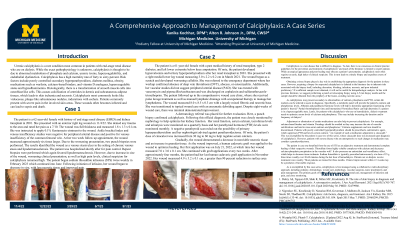Case Series/Study
(CS-085) A Comprehensive Approach to Management of Calciphylaxis: A Case Series

Alton Johnson, DPM, DABPM, FACPM, FASPS, CWSP – Clinical Assistant Professor, Metabolism, Endocrinology and Diabetes, University of Michigan
Introduction: Calciphylaxis is a rare condition with devastating effects and high mortality rates. Clinical manifestations often include formation of ulcerations with skin ischemia and necrosis. To date, there are no clinical practice guidelines for the prevention or treatment of calciphylaxis.
Methods: This case series reports on two patients treated at a large tertiary academic center for calciphylaxis between March 2021 and March 2023. The first patient was a 62 year old female with a history of end stage renal disease on dialysis who was treated for an anterior right leg wound. The second patient was a 61-year-old female with tertiary hyperparathyroidism following renal transplant who was treated for a wound to the medial aspect of her right lower extremity.
Results: The first patient underwent an extensive course of local wound care and was evaluated by several specialists over a course of three months. A wound biopsy aided in the eventual diagnosis of calciphylaxis which ultimately improved with the use of sodium thiosulfate (STS). She continues to receive STS infusions to date. The course of treatment for the second patient’s right lower extremity wound included a combination of medication adjustments, lymphedema therapy, and pulse lavage treatment. She also underwent six applications of human cadaveric skin substitutes every two weeks over a course of three months.
Discussion: This case series exemplifies optimal management of calciphylaxis using a multi-disciplinary approach. This includes evaluation by several specialties, including dermatology, wound care, nephrology, vascular surgery, and pain management. The necessity of obtaining a biopsy for suspected calciphylaxis has been debated in the literature due to inherent risks such as worsening ulceration, bleeding, and infection. This case series demonstrates the importance of identifying a firm diagnosis with the aid of a biopsy obtained with proper technique to allow for swift and timely treatment. Additionally, this case series highlights how appropriate management of co-morbidities and medications plays a key role in the treatment of calciphylaxis. Further studies are required to develop a definitive treatment algorithm.
Trademarked Items:
References:
Methods: This case series reports on two patients treated at a large tertiary academic center for calciphylaxis between March 2021 and March 2023. The first patient was a 62 year old female with a history of end stage renal disease on dialysis who was treated for an anterior right leg wound. The second patient was a 61-year-old female with tertiary hyperparathyroidism following renal transplant who was treated for a wound to the medial aspect of her right lower extremity.
Results: The first patient underwent an extensive course of local wound care and was evaluated by several specialists over a course of three months. A wound biopsy aided in the eventual diagnosis of calciphylaxis which ultimately improved with the use of sodium thiosulfate (STS). She continues to receive STS infusions to date. The course of treatment for the second patient’s right lower extremity wound included a combination of medication adjustments, lymphedema therapy, and pulse lavage treatment. She also underwent six applications of human cadaveric skin substitutes every two weeks over a course of three months.
Discussion: This case series exemplifies optimal management of calciphylaxis using a multi-disciplinary approach. This includes evaluation by several specialties, including dermatology, wound care, nephrology, vascular surgery, and pain management. The necessity of obtaining a biopsy for suspected calciphylaxis has been debated in the literature due to inherent risks such as worsening ulceration, bleeding, and infection. This case series demonstrates the importance of identifying a firm diagnosis with the aid of a biopsy obtained with proper technique to allow for swift and timely treatment. Additionally, this case series highlights how appropriate management of co-morbidities and medications plays a key role in the treatment of calciphylaxis. Further studies are required to develop a definitive treatment algorithm.
Trademarked Items:
References:

.png)